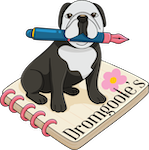There is no bag maker that impresses me more with their quality than Tom Bihn. Just holding and touching their products makes me smile because I can feel the quality in my hands and see it with my eyes. That is before I even begin using their products, which always surprise and delight with their thoughtful design.
I arranged with Tom Bihn a few months ago to test drive and review their Aeronaut 45 max size carry-on for my pen show travels (review coming soon!) and they surprised me with news of a relaunch of their Field Journal Notebook. I reviewed the original model back in 2010, and they asked if I was interested in taking a look at the latest edition. Yes please!
The Tom Bihn Field Journal Notebook was designed as it was named - for work in the field. Think biologists, geologists, park rangers and anyone that needed a durable, weatherproof way to carry their writing and research tools. As it turns out, it is perfect for artists, writers, journalists, students, and anyone else who wants high quality portable storage for their stationery.
With an exterior made from 1000D Cordura, the Field Journal Notebook can get wet, dirty, and take a beating while protecting your writing kit. The water-repellent YKK zippers add to the durability factor, as does the tight stitching. The tolerances on this case are impressive.
If you need maximum storage in a small format then you are in luck. I count 16 different pockets, and knowing Tom Bihn, there is likely another one or two I haven’t discovered yet. All standard pens and mechanical pencils fit with ease, with only the longest wooden pencils needing to be moved to one of the two pouches they can fit in.
The paper is held in place by a small format three-ring binder which accepts 5 1/2” x 8 1/2” paper (exactly half of an 8 1/2” x 11” sheet). You can choose from grid or lined 100% recycled Neenah Conservation Paper when ordering, or add on Crane's Crest 24# 100% cotton paper as an extra.
For testing, I used the same pens across all three papers. While you’d think the two Neenah papers would perform identically, I slight felt differences between the two. The lined was smoother than the grid, but the lined also had more ghosting on the back. There was no real bleed or feathering, even with my fountain pens, so that is a big plus. In a blind test I could possibly tell a difference, but they are the same paper stock and I could be delusional.
The Crane’s Crest is a different animal. It doesn’t have much texture to the touch, but you feel it when writing. My plastic tip drawing pens had trouble on it, leaving a drier line than on the other paper choices. This makes it great for pencil though, and likely watercolors or heavier media. The Crane’s Crest is also the only page that is perforated.
All in all, the paper choices are nice, but if I were a heavy user of the Field Journal I would look at punching my own pages of a paper I know and love.
Filed in the “they thought of everything” category, the three-ring mechanism is removable and can rotate 180 degrees to accommodate left-handed writers, or those writing in other languages. There is also a plastic leaf clipped into the binder that you can move to have a hard backing behind the page when you write.
As with any Tom Bihn product, it is not possible to fawn over it too much. They are that good, and the Field Journal Notebook is no exception. A delightful product made by a delightful company.
The Field Journal Notebook comes in 13 colors with several add-on choices and retails for $90.00.
My thanks to Tom Bihn for sending me this product at no charge for purposes of this review.
Wow has my model grown in 5 1/2 years!























